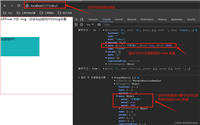说明
修改全局状态变量的值,是一个比较常规而且常见的操作。
本文就介绍四种常见的操作。
由于option store 和setup store 在修改的时候略有不同,所以本文也会将不同点体现一下。
全局状态变量的定义
包含了 option store 和setup store 两种定义方式;
在下面的修改操作中会根据这两种不同的定义来分别阐述。
// 导入 definestore api
import { definestore } from 'pinia'
// 导入 reactive 依赖
import { reactive } from 'vue'
// 定义全局状态方式一 : option store
export const useclassstore = definestore('classinfo',{
state: () => ({
name:'快乐篮球二班',
studentnum:30
}),
actions:{
// 用来更新状态的值
updatename(){
this.name = '使用actions修改的name'
}
}
})
// 定义全局状态方式二 : setup store
export const usestudentstore = definestore('studentinfo',() => {
// 响应式状态
const student = reactive({
name : '小明',
age:12,
classname:'快乐足球一班'
})
// 直接定义一个方法进行数据属性的修改
const updatename = (namep:string)=>{
student.name = namep
}
return { student,updatename }
})
方式一:直接修改
直接修改 : 就是直接读取对象进行变量值的替换。
option store
// 导入全局状态变量的定义
import { useclassstore } from './storea'
// 获取全局状态变量的对象
const classstore = useclassstore()
// 方式一 : 直接修改
classstore.studentnum = 36
setup store
// 导入全局状态变量的定义
import { usestudentstore } from './storea'
// 获取全局状态变量的对象
const studentstore = usestudentstore()
// 方式一 : 直接修改
studentstore.student.classname = '我也不知道是哪个班的'
方式二:$patch 方式修改
参数是一个对象的形式
option store
直接放入 【参数对象】 : {key:value} 就ok了
// 导入全局状态变量的定义
import { useclassstore } from './storea'
// 获取全局状态变量的对象
const classstore = useclassstore()
// 方式二 : $patch 方法修改
classstore.$patch({studentnum:20})
setup store
由于 状态变量在定义的时候,就是一个响应式对象,所以需要把整个的对象都放进去才ok。
// 导入全局状态变量的定义
import { usestudentstore } from './storea'
// 获取全局状态变量的对象
const studentstore = usestudentstore()
// 方式二 : $patch 方法修改
studentstore.$patch({student:{
name: studentstore.student.name,
age: studentstore.student.age,
classname:'又换了一个班级'
}})
方式三:$patch 带参数的方式修改
参数是 函数的形式,且函数的参数就是 原state对象
这种方式用起来比【方式二】要更加灵活。
option store
// 导入全局状态变量的定义
import { useclassstore } from './storea'
// 获取全局状态变量的对象
const classstore = useclassstore()
// 方式三 :$patch + 函数参数的方法修改 : 函数的参数就是 状态对象
classstore.$patch((state)=>{
console.log(state)
state.studentnum = 100
})
setup store
// 导入全局状态变量的定义
import { usestudentstore } from './storea'
// 获取全局状态变量的对象
const studentstore = usestudentstore()
// 方式三 :$patch + 函数参数的方法修改 : 函数的参数就是 状态对象
studentstore.$patch((state)=>{
console.log(state)
state.student.classname = '超级无敌快乐踢足球的班'
})
方式四:actions方法的方式进行修改
这种方式比较好理解,就是通过调用已经定义好的方法的方式来进行变量值的修改。
也比较推荐使用这一种方式。
option store
// 导入全局状态变量的定义
import { useclassstore } from './storea'
// 获取全局状态变量的对象
const classstore = useclassstore()
// 方式四 :actions 方法的方式进行数据的修改
classstore.updatename()
setup store
// 导入全局状态变量的定义
import { usestudentstore } from './storea'
// 获取全局状态变量的对象
const studentstore = usestudentstore()
// 方式四 :actions 方法的方式进行数据的修改
studentstore.updatename('小红')
总结
以上为个人经验,希望能给大家一个参考,也希望大家多多支持代码网。




发表评论